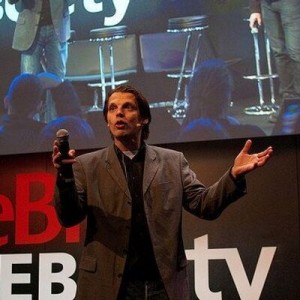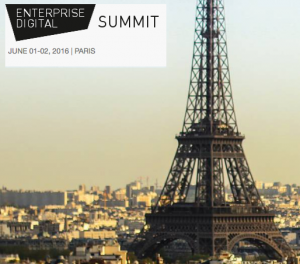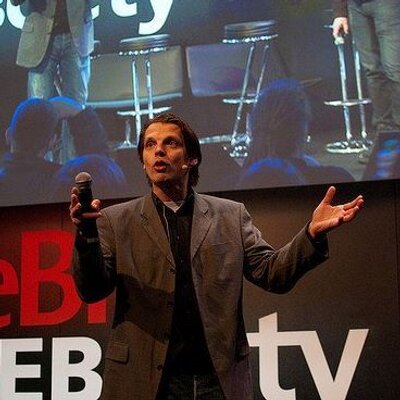Several Lecko customers will talk at the event (Sodexo, Air France, …) as well as great speakers (see detailed agenda there), furthermore, we will present a summary of our last study :ESN vol 8. The fact that more and more customer facing business lines and workers adopt business oriented social usages is really a meaningful signal. The conference will be a great opportunity to feel the pulse of digital transformation !
BN : What are your drawbacks on the reasons for this low-understanding of the transformational power of those networks?
ME : Most professional now understand the need of transformation, whether because they are scared to be uberized or because they see it as an opportunity or at least because they don’t want to stay on the side of the road.
But it takes time to convert this awareness into concrete, daily practices, and companies don’t give themselves much time nowadays.
 BN :Isn’t the positioning of the “social initiative” as Enterprise Social Networking already the wrong approach? Shouldn’t the “collaborative idea” be the central part of this approach?
BN :Isn’t the positioning of the “social initiative” as Enterprise Social Networking already the wrong approach? Shouldn’t the “collaborative idea” be the central part of this approach?
ME : Yes and that’s why we observe on the field : the priority comes back to collaboration, where the business value is : collaborate efficently on business matters first, social will come naturally !
With the development of new tools and their ease of deployment, the idea of a unique, global corporate ESN for the whole company is no more realistic. Corporate IT must provide a framework and at the same time accept that their users develop multiple usages with multiple tools.
BN : What are your recommendations for changing this situation and for unfolding the transformational effects of the collaborative approach?
ME : I think the transformation is on it way. We just have to foster it by :
– Large acculturation programmes to develop a fertile soil
– Identifying change leaders, help them, recognize them, coach them : they are the engine
– Communicate on the success stories (rather than on potential benefits)
– Setup a collaborative governance of digital transformation, including all stakeholders and not siloed by technologies (Intranet / ESN / Productivity / …).
BN :At the Enterprise Digital SUMMIT we are emphasizing the advancements in AI technology and the market forces of platform models as new change drivers for the digital transformation. What is your opinion on this in regards to the results of your research?
ME : Technologies are evolving fast (big data, AI, …) but especially for B2E technologies, the limiting factor is employee adoption ! Companies don’t have time to deploy, really adopt a tool that it’s already obsolete. We have to move forward to the next generation without having fully collected the benefits of the previous one ! We notice everyday how the corporate world is late in terms of digital usages compared to the real world. This being said, adding AI to social & collaboration usages represent a huge potential and many possible applications. Especially for HR and Comms : interpreting the social graph, understanding trending topics into the organization, detecting leaders, suggesting really significant content to employees, …
AI will introduce predictive analysis. Predicting the success of a community, of a project, of solving a given problem for instance. I hope it will not lead to the translation of minority report scenario to the entreprise : predicting employees success or failure !
BN : What are your expectations for the Enterprise Digital SUMMIT?
Have fun, network with colleagues, meet practicioners, learn from great case studies, and sense how digital transformation is progressing !
This interview has also been published there : http://blog.enterprise-digital.net/enterprise-digital-summit-blog/
]]>

The next Enterprise Digital Summit will take place in Paris, 1rst and 2nd of June. At this occasion, I had a good chat with Bjoern Negelmann, the conference organizer around the preparation of the event, my expectations and of course our perception of digital transformation. Below is the 1rst part (out of 2) of my interview.
Several Lecko customers will talk at the event (Sodexo, Air France, …) as well as great speakers (see detailed agenda there), furthermore, we will present a summary of our last study : ESN vol 8. The conference will be a great opportunity to feel the pulse of digital transformation !
Bjoern: Michel, you will again present the latest key findings from Lecko’s research on the state of the ESN establishment within large companies. What are the three key tags that characterize the key results?
Michel: Beyond ESN establishment, we assess the state and progresses of digital transformation within organisations. But it’s true that the ESN, inspite of it’s virtual nature is, in a way, the materialization of digital transformation, it is the place where new work practices happen.
To answer your question, the 3 tags that summarize the whole story are :
- Awareness
- Sense of emergency
- Lack of practice
Michel: This year we professionalized even more our study by building it in partnership with opinion way, a poll institute, which enabled us to have a scientific approach and collect the perception of digital transformation of a representative set of managers. This way we have an accurate representation of the reality of digital transformation in companies based in France, larger than 5000 employees. Other new stuff : our collaboration with our partner and counterpart in UK, Agile Elephant. The idea is to give an international endeavor to our research and compare results in France to UK and the rest of Europe.

Bjoern: What have been the key finding from this year’s additional interrogation of senior managers on their views of the ESN as tool and enabler for the digital transformation. Are they aware of the importance of the connection between the internal and external transformation efforts?
- Best practices and experience sharing in retail distribution networks (shops) in the luxury industry (clothes, perfumes, jewelry, …)
- Collecting and discussing feedback on products and services among Air France – KLM cabin crews (Air France digital transformation leader will talk at the Paris conference)
- Massive participative innovation at Sodexo, who will also talk at the Paris summit
- Large Best practices & problem solving communities in the Construction and work industry
This interview has also been published there : http://blog.enterprise-digital.net/enterprise-digital-summit-blog/
]]>
Lundi dernier se déroulait l’une des premières conférences de la Social Media Week. A cette occasion, la Mairie de Paris organisait une conférence sur les médias sociaux, et plus globalement sur la nouvelle complicité qu’ils pouvaient créer entre les villes et ses usagers.
Mais qu’est-ce que la Social Media Week ?
Lancée il y a 5 ans par une société New-Yorkaise (Crowdcentric), il s’agit d’une semaine d’événements consistant à décrypter l’impact des médias sociaux à travers les angles culturel, économique et social. Cette semaine, réalisée en parallèle dans 10 villes internationales pour la session de février 2013, regroupait 62 conférences et débats rien que sur la ville de Paris. Voici un résumé sur celle organisée par la Mairie de Paris et la divulgation de quelques exclusivités !
Le Fix my street parisien : “Dans ma rue”
La première des exclusivités concerne la mise en place dans Paris de l’équivalent du Fix my street britannique. Cette application qui s’appellera sûrement “Dans ma rue” vise à géolocaliser et prendre en photo les problèmes dans la rue. Ce signalement sera ensuite transmis aux services de la ville pour traiter la demande. De tels projets sont déjà en production à Poitiers ou à Mérignac. Pour la ville de Paris il s’agira d’élargir le nombre d’utilisateurs. En effet, les agents utilisent déjà l’application pour faciliter leur travail quotidien !
Pour aller plus loin : http://www.leproblemedemarue.fr / http://www.jaimemarue.com
Le Yahoo answers parisien : “Paris Answers”
Le plus connu des exemples, parmi le développement des Foires Aux Questions collaboratives, réside dans le projet de Yahoo, appelée Yahoo Answers. Le principe est simple. Quelqu’un pose une question, et l’ensemble des visiteurs peuvent y répondre. S’appuyant sur le principe de crowdsourcing, il réunit en un lieu le savoir de milliers de personnes. Les réponses les plus pertinentes pouvant remonter grâce au vote de chacun. Cette conférence nous a appris que la ville de Paris réfléchissait à un tel principe, afin d’agréger en un lieu unique des questions fréquemment posées, et dont les citoyens pouvaient déjà avoir la réponse. Une solution pour concilier l’exigence d’immédiateté et le temps de la Ville ?
Pour aller plus loin : Yahoo Answers
Le crowdfunding parisien
Autre nouveauté à venir, la possibilité pour les citoyens de participer au financement de projets de la ville de Paris. Ce projet, suivant comment il est construit, peut être assez polémique. Pourquoi les citoyens devraient-ils participer alors qu’ils paient déjà des impôts ? Comment construire le système pour développer équitablement le territoire ? Il est possible que les financeurs potentiels les plus riches, participent plus facilement au développement de leur propre quartier ! Enfin, quel incitation créer, pour motiver les gens à donner de l’argent dans un contexte difficile ? Jean-Philippe Clément, Chargé de mission TIC et Innovation pour la Mairie de Paris, nous a indiqué qu’un important travail juridique était encore à mener pour que ce projet voit le jour.
Pour aller plus loin : Le crowdfunding peut-il remplacer les services publics ? / crowdfunding du Centre des Monuments Nationaux
]]>S’agissant de la fronde menée à l’encontre de Berlusconi sur le web, la mobilisation citoyenne sur les réseaux sociaux a aboutit à des manifestations dans les rues de Rome. Cela a pu se réaliser grâce à un appel à rassemblement des manifestants sur les pages Facebook dédiées à l’événement. L’audience de ce type de manifestation, dont le point de départ est un réseau social type Facebook ou Twitter dépasse le web et aboutit au final, un relai tout d’abord du web à l’étranger puis de la presse écrite l’internationale.

Egalement relayée, la tentative d’interdiction de ces pages, du moins la critique par le Ministère de la Justice Italienne des ces attroupements sur les réseaux sociaux aura un effet contreproductif pour le gouvernement italien. Les commentateurs vont s’insurger contre une tentative de reprise en main du web par les autorités, alimentant un peu plus le coté négatif de Berlusconi, à l’origine de la fronde sur le web.
Dans un sens plus positif, un comité de soutien s’est initialisé sur les réseaux sociaux pour la création d’une extension de nom de domaine en “.paris” sous la forme Soutenons Point Paris. Cette action citoyenne revêt la forme des lobbying qui témoignent de leur projet et du bien fondé de celui-ci d’une part auprès des instances décisionnaires et d’autres part au près des relais d’opinion ou cercles d’influences.

La différence entre ces deux formes de mobilisation tient à l’existence, ou non d’opposition. Dans le cas Berlusconi, l’opposition est à l’origine même de la création de groupe sur les réseaux sociaux, tandis que dans le cas de “Soutenons .paris” il s’agit d’un groupe sans véritable opposition, du moins a priori. Les groupes constitués ont donc pour principale action de communiquer et non de contre-attaquer.
La présence sur le web s’inscrit dans une démarche globale de communication dans les cas de mobilisation citoyenne. L’essentielle est d’être relayée. Pour cela, l’attaque développe plus de réactivité : de “Uccidiamo Berlusconi” (sortons Berlusconi)on est passé à “berlusconi,ora che abbiamo la tua attenzione…RISPONDI ALLE NOSTRE DOMANDE” (Berlusconi, maintenant que nous avons ton attention, réponds à notre demande).

Cette évolution dans la création successive de page Facebook témoigne de la volonté de dialogue, voir de constatation d’un refus de dialogue de la part de l’intéressé. Au final, ce groupe se place comme interlocuteur incontournable et maintient la lumière sur leur mouvement.
Deux situations, deux techniques d’utilisation des réseaux sociaux qui incluent toute deux les réseaux sociaux dans une stratégie de communication avec les institutions.
Liens
- Concernant Berlusconi :
http://www.facebook.com/group.php?gid=174369200668
http://twitter.com/NoBerlusconi
- Concernant Soutenons Point Paris
http://www.facebook.com/pages/SoutenonsPointParis/190045457314?ref=mf&v=wall
]]>